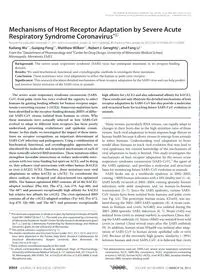
2012 Mechanisms of Host Receptor Adaptation by Severe Acute Respiratory Syndrome Coronavirus PDF
Preview 2012 Mechanisms of Host Receptor Adaptation by Severe Acute Respiratory Syndrome Coronavirus
Mechanisms of Host Receptor Adaptation by Severe Acute Respiratory Syndrome Coronavirus*□ S Received for publication,November 21, 2011, and in revised form, January 26, 2012 Published, JBC Papers in Press,January 30, 2012, DOI 10.1074/jbc.M111.325803 Kailang Wu‡1, Guiqing Peng‡1, Matthew Wilken‡1, Robert J. Geraghty§, and Fang Li‡2 From the ‡Department of Pharmacology and §Center for Drug Design, University of Minnesota Medical School, Minneapolis, Minnesota 55455 Background: The severe acute respiratory syndrome (SARS) virus has undergone mutations in its receptor-binding domain. Results: We used biochemical, functional, and crystallographic methods to investigate these mutations. Conclusion: These mutations were viral adaptations to either the human or palm civet receptor. Significance: This research elucidates detailed mechanisms of host receptor adaptation by the SARS virus and can help predict and monitor future evolution of the SARS virus in animals. The severe acute respiratory syndrome coronavirus (SARS- CoV) from palm civets has twice evolved the capacity to infect humans by gaining binding affinity for human receptor angio- tensin-converting enzyme 2 (ACE2). Numerous mutations have been identified in the receptor-binding domain (RBD) of differ- ent SARS-CoV strains isolated from humans or civets. Why these mutations were naturally selected or how SARS-CoV evolved to adapt to different host receptors has been poorly understood, presenting evolutionary and epidemic conun- drums. In this study, we investigated the impact of these muta- tions on receptor recognition, an important determinant of SARS-CoV infection and pathogenesis. Using a combination of biochemical, functional, and crystallographic approaches, we elucidated the molecular and structural mechanisms of each of these naturally selected RBD mutations. These mutations either strengthen favorable interactions or reduce unfavorable inter- actions with two virus-binding hot spots on ACE2, and by doing so, they enhance viral interactions with either human (hACE2) or civet (cACE2) ACE2. Therefore, these mutations were viral adaptations to either hACE2 or cACE2. To corroborate the above analysis, we designed and characterized two optimized RBDs. The human-optimized RBD contains all of the hACE2- adapted residues (Phe-442, Phe-472, Asn-479, Asp-480, and Thr-487) and possesses exceptionally high affinity for hACE2 but relative low affinity for cACE2. The civet-optimized RBD contains all of the cACE2-adapted residues (Tyr-442, Pro-472, Arg-479, Gly-480, and Thr-487) and possesses exceptionally high affinity for cACE2 and also substantial affinity for hACE2. These results not only illustrate the detailed mechanisms of host receptor adaptation by SARS-CoV but also provide a molecular and structural basis for tracking future SARS-CoV evolution in animals. Many viruses, particularly RNA viruses, can rapidly adapt to changes in their hosts due to the high mutation rates of these viruses. Such viral adaptation to hosts imposes huge threats to human health because it allows viruses to emerge from animals to infect humans. Understanding viral adaptation to hosts would allow humans to track viral evolution that may lead to viral epidemics, but current knowledge of the mechanisms of viral adaptation to hosts is limited. This study investigates the mechanisms of host receptor adaptation by the severe acute respiratory syndrome coronavirus (SARS-CoV),3 the agent of the SARS epidemic, and provides a molecular and structural basis for monitoring future SARS-CoV evolution in animals. SARS broke out as a worldwide epidemic in 2002–2003, causing �8000 human infections with a 10% fatality rate (1–4). SARS briefly recurred in 2003–2004, causing sporadic human infections with mild symptoms and no human-to-human transmission (5–7). Since the SARS epidemic, various SARS- CoV strains have been isolated from humans and palm civets (see Fig. 1A). The prototypic human strain, hTor02, was iso- lated during the 2002–2003 SARS epidemic (8). A strain com- mon to humans and civets, hcGd03, was isolated during the 2003–2004 sporadic SARS infections (6, 7). Strain cSz02 was isolated from civets in animal markets in southern China dur- ing the SARS outbreak (5). Strain cHb05 was isolated from wild civets in central China several years after the SARS outbreak (9). In addition, human strain hHae08 was isolated after adap- tation of SARS-CoV to human airway epithelial cells in vitro (10). Because of the extremely high genetic similarity (�99%) between human and civet SARS-CoV, it is believed that civets * Thisworkwassupported,inwholeorinpart,byNationalInstitutesofHealth Grant R01 AI089728 (to F. L.). This work was also supported by a University of Minnesota Academic Health Center faculty research development grant (to F. L.) and by a Minnesota Partnership for Biotechnology and Medical Genomics grant (to the University of Minnesota). □ S This article contains supplemental Fig. S1. The atomic coordinates and structure factors (codes 3SCI, 3SCJ, 3SCK, and 3SCL) have been deposited in the Protein Data Bank, Research Collaboratory for Structural Bioinformatics, Rutgers University, New Brunswick, NJ (http://www.rcsb.org/). 1 These authors contributed equally to this work. 2 To whom correspondence should be addressed: Dept. of Pharmacology, University of Minnesota Medical School, 6-121 Jackson Hall, 321 Church St. SE, Minneapolis, MN 55455. Tel.: 612-625-6149; Fax: 612-625-8408; E-mail:
